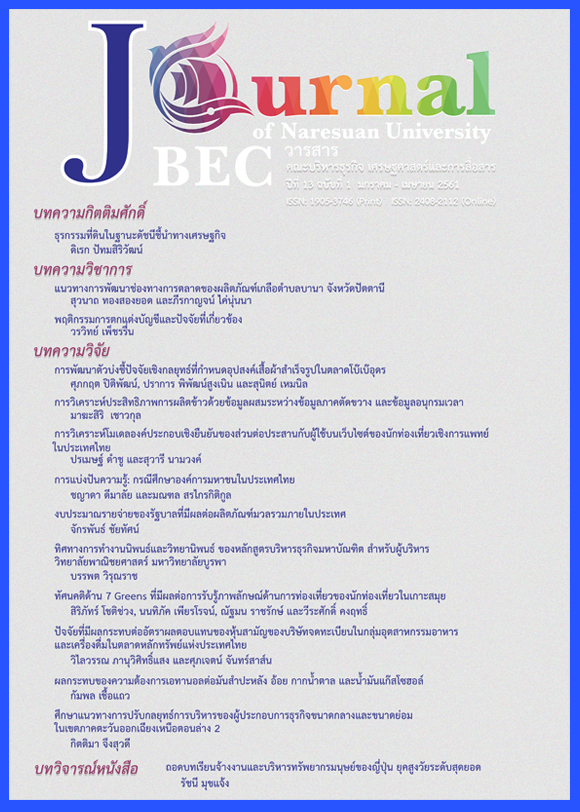งบประมาณรายจ่ายของรัฐบาลที่มีผลต่อผลิตภัณฑ์มวลรวมภายในประเทศ [The Impact of Government Budgetary Expenditure on the Gross Domestic Product]
Main Article Content
Abstract
This research has an objective that is to analyze the relationship between budget expenditures classified by functions and Gross Domestic Product (GDP) by four steps of econometric techniques. These techniques included 1) Unit Root test, 2) Cointegration test, 3) Error Correction Model, and 4) Granger Causality test. The results of the study found that the data of the budget expenditures classified by functions and the data of GDP were at a stationary stage at the level of I(1). These two data sets had a Long-term relationship in the same direction at significance level of .05. For the results of short-run equilibrium relationship, it found that the budget expenditures classified by functions had no relationship with the GDP. Then, the causality between variables was tested. It found that the budget expenditures classified by functions caused a change of GDP. When the government increased budget expenditures for economic affairs 1 million Baht, it would increase GDP by 2.627 million Baht. When the government increased budget expenditures for educational affaires by 1 million, it would increase GDP by 17.715 million Baht. When the government increased budget expenditures for public health by 1 million Baht, it would increase GDP by 7.049 million Baht. When the government increased budget expenditures for public debt transactions by 1 million Baht, it would increase GDP by 2.483 million Baht.
Article Details
References
2. Bureau of the Budget. (1982-2015). Thailand’s budget in brief fiscal year 1982-2015. Bangkok: Bureau of the Budget, The Prime Minister’s Office.
3. Chaithat, C., Chomchuen, T. and Manussanit, W. (2016). An analysis of the budget expenditures appropriation for education effected on the northern region economic growth. Journal of Business, Economics and Communications, 11(2), 69-73.
4. Dickey, D. A. and Fuller, W. A. (1979). Distribution of the estimators for autoregressive time series with a unit root. Journal of the American statistical association, 74(366a), 427-431.
5. Engle, R. F. and Granger, C. W. (1987). Co-integration and error correction: Representation, estimation and testing. Econometrica: Journal of the Econometric Society, 55(2), 251-276.
6. Granger, C. W. (1969). Investigating causal relations by econometric models and cross - spectral methods. Econometrica: Journal of the Econometric Society, 37(3), 424-438.
7. Henrekson, M. (1993). Wagner's law-a spurious relationship?. Public Finance, 48(2), 406-415.
8. Jaithoum, P. (2010). An analysis of the relationship between current expenditure of government, capital expenditure of government and gross domestic product of Thailand. Independent Study, M. Econ., Chiang Mai University, Chiang Mai.
9. Loizides, J. and Vamvoukas, G. (2005). Government expenditure and economic growth: Evidence from trivariate causality testing. Journal of Applied Economics, 8(1), 125-152.
10. MacKinnon, J. G. (1996). Numerical distribution functions for unit root and cointegration tests. Journal of Applied Econometrics, 11(6), 601-618.
11. Mingmaninakin, W. (2012). Principles of economics. Bangkok: Thammasat University press.
12. Office of the Nation Economic and Social Development Board. (2017). Regional products and province. Retrieved April 10, 2017, from http://www.nesdb.go.th/more_news.php?cid= 564&filename= index
13. Sinha, D. (1998). Government expenditure and economic growth in Malaysia. Journal of Economic Development, 23(2), 71-80.
14. Sommit, R. (2007). The Role of government expenditure on the macroeconomic variables in Thailand. Master thesis, M. Econ., ChiangMai University, Chiang Mai.
15. Sukkapat, P. (2008). An analysis of relationship between public education and economic growth of Thailand. Independent Study, M. Econ., Chiang Mai University, Chiang Mai.
16. Thailand Development Research Institute. (2015). Strengths and weaknesses of Thai economy. TDRI Report, 111, 3-7.
17. Thanapatkuntorn, N. (2013). The effects of government expenditure and taxation. Independent Study, M. Econ., Chiang Mai University, Chiang Mai.
18. Vasudeva, N. R. M. (1993). Further evidence of Wagner's law for Mexico: An application of cointegration analysis. Public Finance = Finances Publiques, 48(1), 92-96.

